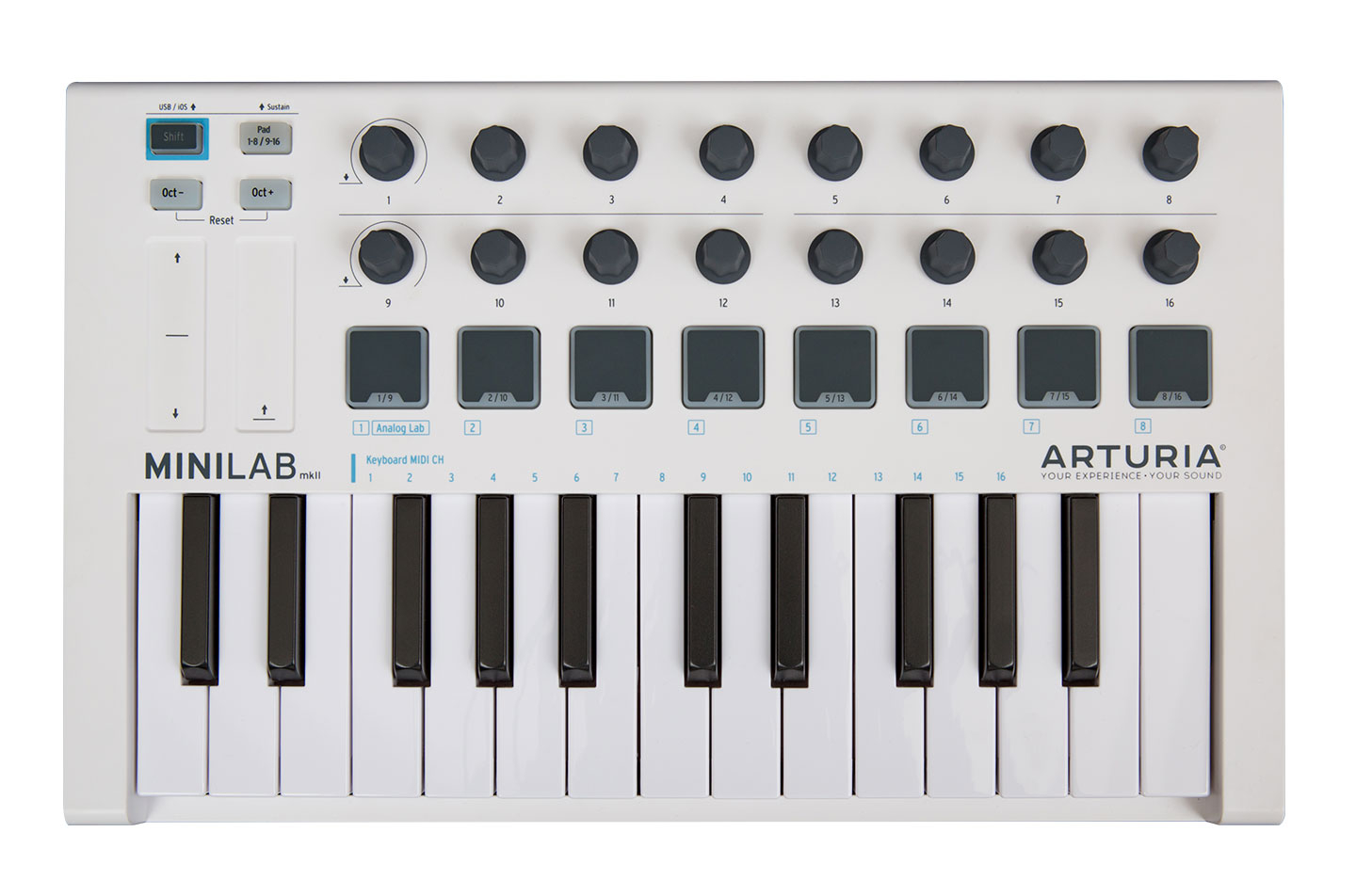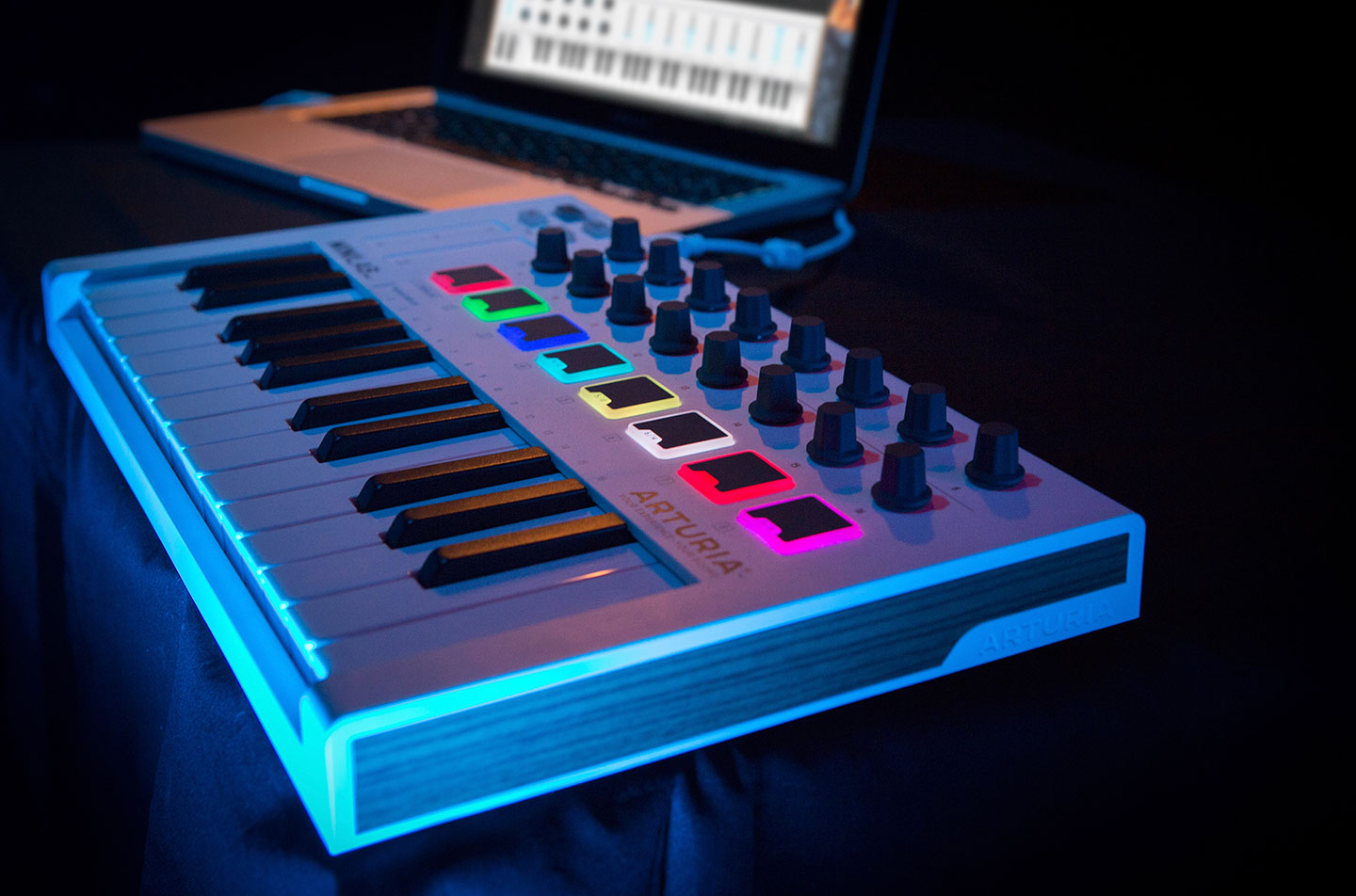- When Arturia released the original MiniLab compact MIDI keyboard controller back in 2013, one of its main selling points was tight integration with a bundled piece of software called Analog Lab. Similar to Native Instruments' Komplete Selections, Analog Lab was designed to provide a generous array of over 5000 playable presets from Arturia's family of virtual instruments. Combining this sound library with a portable, velocity-sensitive, iOS-compatible keyboard controller for a street price of about $100 made it a tempting option for many producers. However, reports of build quality issues and complications with non-Arturia software eventually surfaced. When it came time to develop the next generation of the controller, Arturia invested much more heavily on the hardware itself. The MiniLab Mk II was the result of those efforts.
Arturia devoted particular attention to a redesign of the keybed. To gain a bit more room to work with, the pitchbend and modwheel touch strips were moved up next to the drum pads. The function buttons that previously held that spot were also pushed up to where the logo was. This was a smart decision that had the positive effects of both widening the keybed itself and reducing the overall width of the instrument. This increased real estate for the keys combined with higher overall build quality resulted in one of the best (if not the best) mini-keyboard I've ever used. The keys are lively and responsive but have a good balance of weight. I also didn't notice any unevenness in the velocity sensitivity of the black keys, a symptom which plagues more than one affordable MIDI keyboard. The pitchbend and modwheel touchstrips were reportedly also redesigned to improve playability. Having not used the original, I can't vouch for this personally but they felt perfectly functional during my tests.
Another major difference on the Mk II hardware can be found in the encoders. Numbers 1 and 9 are now clickable, multi-function encoders capable of sending three different messages. One is sent by turning, another while clicking and the last by holding shift and turning the encoder. The benefit of this new design can be seen immediately in Analog Lab, where the two encoders can now be used to browse the preset library in a much more efficient manner. Encoder 1 scrolls through the preset list and can now select a preset by clicking. Encoder 9 lets you narrow down the list of presets by scrolling through and selecting from the preset filtering options. You can also quickly move forward and backwards through a list of presets using drum pads 9 and 10. This behaviour is much improved over the original MiniLab's integration with Analog Lab, and is now on par with Native Instruments' Komplete Kontrol keyboard browse menu.
Ironically, while the preset browsing experience is much improved, the MiniLab Mk II ships with a much smaller library of presets to select from than its predecessor. That's due to the fact that Arturia now bundles the controller with Analog Lab Lite, a trimmed-down version of what came with the original. This means that rather than the full version's 5000 sounds, you get around 500. But you can upgrade to the full Analog Lab 2 library or even to V Collection 5 for a price. This upgrade offer depends on what Arturia products you happen to own, but for me personally it would cost 44 Euro to upgrade to Analog Lab 2 and 249 Euro to upgrade to V Collection 5. The MiniLab Mk II does however come with something that the original didn't: a multisampled piano instrument from UVI called Grand Piano Model D, which may take some of the sting away from getting less on the Analog Lab side of things. Some have speculated that Arturia made these choices due to the fact that the better build quality led to increased hardware manufacturing costs with the Mk II.
Personally, I think this was the right decision. I would prefer to get better hardware for the same price with the option to upgrade the software if I got enough use out of the bundled lite version. This was the first time I had used Analog Lab, and I came away with mixed feelings about it. There were definitely some interesting sounds that I could use in my productions but during my tests I eventually became frustrated by the inability to edit the patches beyond using the preassigned macros. Evidently this functionality is enabled if you own V Collection 5 but not any of its previous versions. Even being able to change arpeggiator settings on patches would be a great option to have within Analog Lab but that's apparently also hidden within the presets rather than offered in the main UI like it is in Komplete Kontrol.
The last of the big changes Arturia made in the design of the MiniLab Mk II is the addition of RGB backlighting on the drum pads. This allows them to display multiple colours, which can be assigned to the 16 pads (there are two banks of 8 available) within Arturia's MIDI Control Center application. The control template for Ableton Live also reportedly takes advantage of this functionality, providing feedback of clip or track states. However, at the time of this review, the template was not yet available for download from Arturia or Ableton.
Overall, it seems clear that Arturia's focus when designing the MiniLab Mk II moved away from the integration with Analog Lab and towards a more wholistic approach of producing a high quality, portable MIDI keyboard. For controlling iOS instruments, it's a fantastic option offering ample controls and the ability to quickly change presets and MIDI channels right from the hardware. It would also be great for studios short on space or for producers to take on the road, assuming that you don't require hardware MIDI ports (neither generation of the MiniLab has them). The change in Analog Lab may be a bit of a bummer for some folks, but Arturia more than makes up for it in the improved quality of the hardware.
Ratings:
Cost: 4.0
Versatility: 4.0
Ease of use: 4.5
Build Quality: 4.8
 The last of the big changes Arturia made in the design of the MiniLab Mk II is the addition of RGB backlighting on the drum pads. This allows them to display multiple colours, which can be assigned to the 16 pads (there are two banks of 8 available) within Arturia's MIDI Control Center application. The control template for Ableton Live also reportedly takes advantage of this functionality, providing feedback of clip or track states. However, at the time of this review, the template was not yet available for download from Arturia or Ableton. Overall, it seems clear that Arturia's focus when designing the MiniLab Mk II moved away from the integration with Analog Lab and towards a more wholistic approach of producing a high quality, portable MIDI keyboard. For controlling iOS instruments, it's a fantastic option offering ample controls and the ability to quickly change presets and MIDI channels right from the hardware. It would also be great for studios short on space or for producers to take on the road, assuming that you don't require hardware MIDI ports (neither generation of the MiniLab has them). The change in Analog Lab may be a bit of a bummer for some folks, but Arturia more than makes up for it in the improved quality of the hardware. Ratings: Cost: 4.0 Versatility: 4.0 Ease of use: 4.5 Build Quality: 4.8
The last of the big changes Arturia made in the design of the MiniLab Mk II is the addition of RGB backlighting on the drum pads. This allows them to display multiple colours, which can be assigned to the 16 pads (there are two banks of 8 available) within Arturia's MIDI Control Center application. The control template for Ableton Live also reportedly takes advantage of this functionality, providing feedback of clip or track states. However, at the time of this review, the template was not yet available for download from Arturia or Ableton. Overall, it seems clear that Arturia's focus when designing the MiniLab Mk II moved away from the integration with Analog Lab and towards a more wholistic approach of producing a high quality, portable MIDI keyboard. For controlling iOS instruments, it's a fantastic option offering ample controls and the ability to quickly change presets and MIDI channels right from the hardware. It would also be great for studios short on space or for producers to take on the road, assuming that you don't require hardware MIDI ports (neither generation of the MiniLab has them). The change in Analog Lab may be a bit of a bummer for some folks, but Arturia more than makes up for it in the improved quality of the hardware. Ratings: Cost: 4.0 Versatility: 4.0 Ease of use: 4.5 Build Quality: 4.8